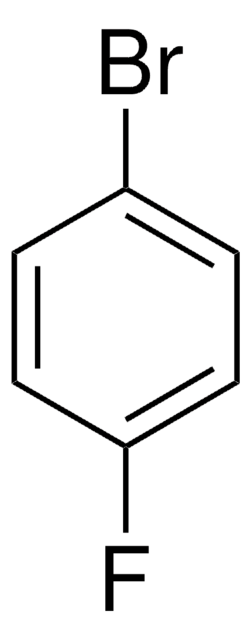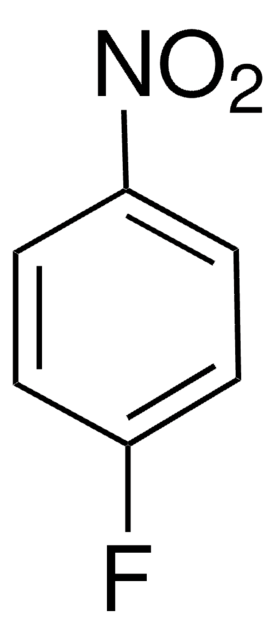F6001
Fluorobenzene
99%
Synonym(s):
Monofluorobenzene, Phenyl fluoride
Sign Into View Organizational & Contract Pricing
All Photos(1)
About This Item
Empirical Formula (Hill Notation):
C6H5F
CAS Number:
Molecular Weight:
96.10
Beilstein:
1236623
EC Number:
MDL number:
UNSPSC Code:
12352100
PubChem Substance ID:
NACRES:
NA.22
Recommended Products
vapor density
3.31 (vs air)
Quality Level
Assay
99%
refractive index
n20/D 1.465 (lit.)
bp
85 °C (lit.)
mp
−42 °C (lit.)
density
1.024 g/mL at 25 °C (lit.)
SMILES string
Fc1ccccc1
InChI
1S/C6H5F/c7-6-4-2-1-3-5-6/h1-5H
InChI key
PYLWMHQQBFSUBP-UHFFFAOYSA-N
Looking for similar products? Visit Product Comparison Guide
Application
Fluorobenzene is generally used as a solvent in synthetic chemistry. It can also be used as an aryl fluoride precursor in the nickel-catalyzed cross-coupling reactions.
Signal Word
Danger
Hazard Statements
Precautionary Statements
Hazard Classifications
Aquatic Chronic 2 - Eye Dam. 1 - Flam. Liq. 2
Storage Class Code
3 - Flammable liquids
WGK
WGK 2
Flash Point(F)
5.0 °F - closed cup
Flash Point(C)
-15 °C - closed cup
Personal Protective Equipment
dust mask type N95 (US), Eyeshields, Gloves
Choose from one of the most recent versions:
Already Own This Product?
Find documentation for the products that you have recently purchased in the Document Library.
Customers Also Viewed
Nickel-catalyzed Suzuki-Miyaura reaction of aryl fluorides.
Tobisu, Mamoru et al.
Journal of the American Chemical Society, 133(48), 19505-19511 (2011)
Reactions of a cyclic rhodium carbenoid with aromatic compounds and vinyl ethers.
Pirrung, Michael C et al.
The Journal of Organic Chemistry, 60(7), 2112-2124 (1995)
Coordinatively unsaturated ruthenium phosphine half-sandwich complexes: Correlations to structure and reactivity.
Aneetha, Halikhedkar et al.
Organometallics, 21(24), 5334-5346 (2002)
Fidel Ortega-Gavilán et al.
Food chemistry, 322, 126743-126743 (2020-04-14)
Sensory properties are critical characteristics that determine quality and can be evaluated by trained tasting panels. The panels function as multi-sensor measuring instrument and need the use of reference materials (RMs) for training. The homogeneity between units packaged from a
Lucia Valverde-Som et al.
Journal of the science of food and agriculture, 98(11), 4245-4252 (2018-02-10)
The organoleptic quality of virgin olive oil depends on positive and negative sensory attributes. These attributes are related to volatile organic compounds and phenolic compounds that represent the aroma and taste (flavour) of the virgin olive oil. The flavour is
Our team of scientists has experience in all areas of research including Life Science, Material Science, Chemical Synthesis, Chromatography, Analytical and many others.
Contact Technical Service
















